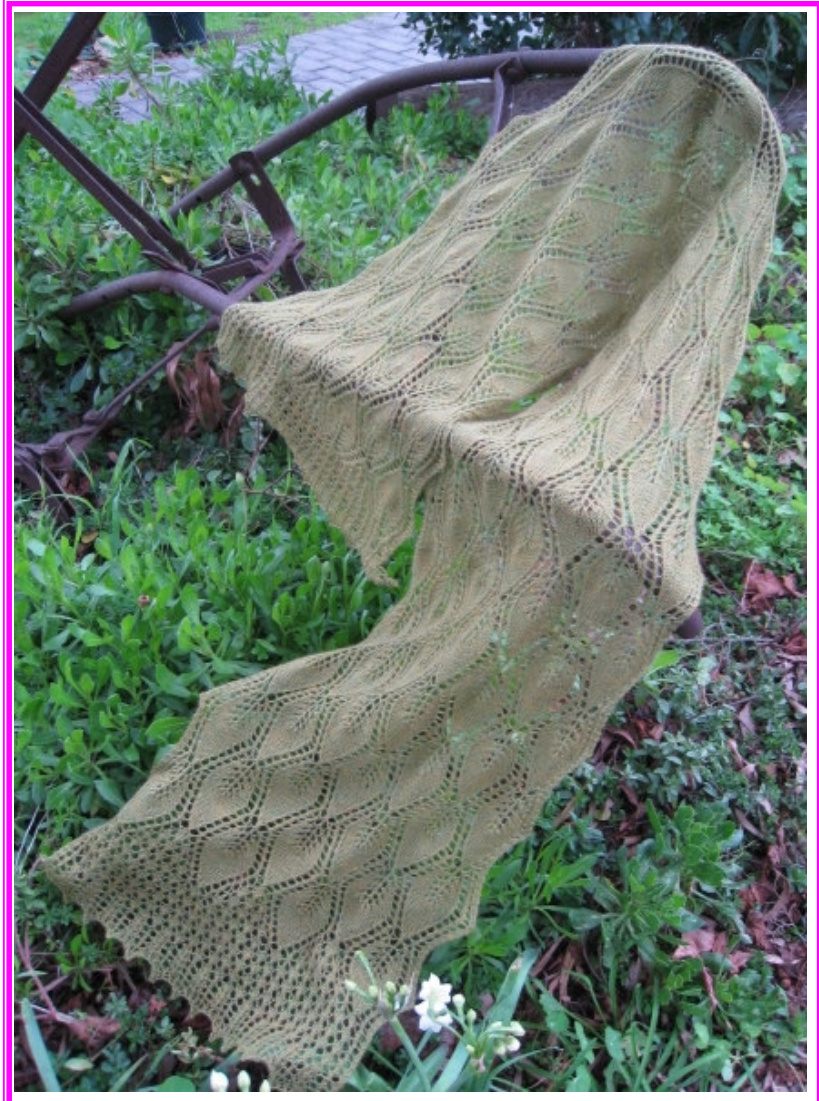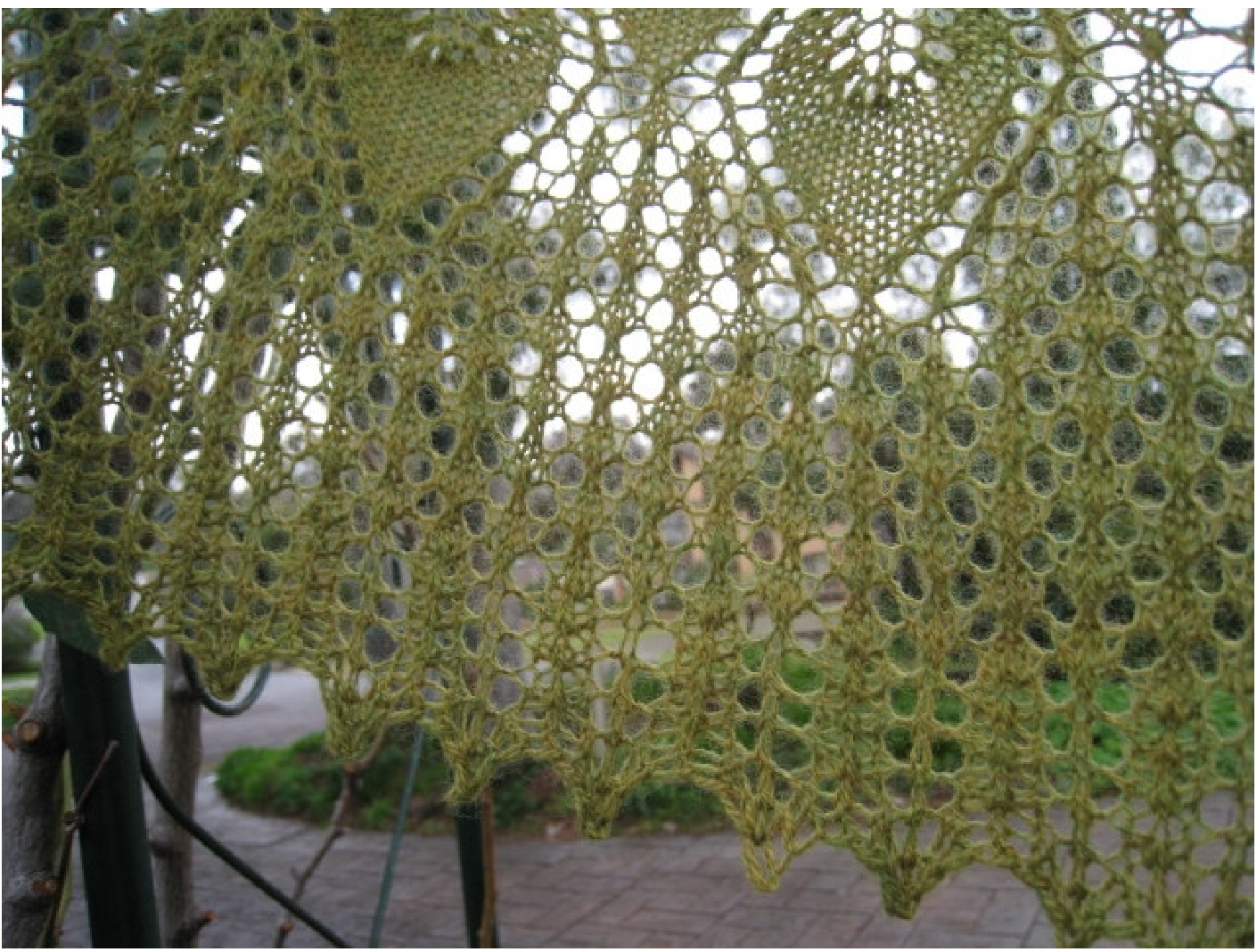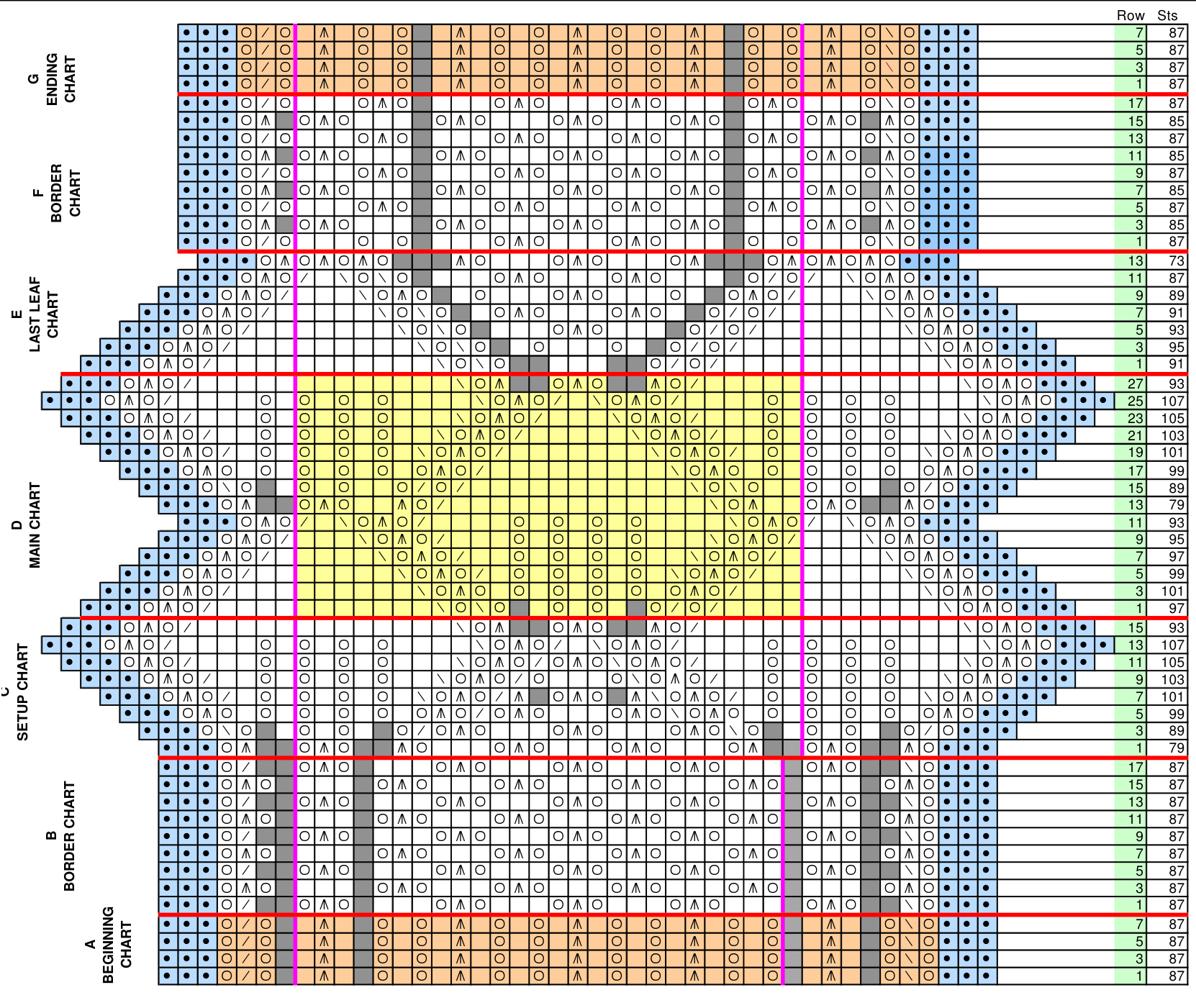AWinter Leaves
A rectangulan Lace Scant/Shawl by Colleen Anchbold A rectangular version of the "Frozen Leaves" triangle shawl by Anna (Anusla) on Ravelry, charted and described in English by Sandra (Sandralice) and Karen (Like2knit) also on Ravelry. This version has scalloped sides following the curves of the leaves and is knit from the beginning to end without provisional cast on or grafting. The main leaf pattern becomes quite easy to remember. The stitch count changes throughout the leaf repeat, and this is clearly shown in the pattern. To change the length the leaf pattern can be repeated more times, and to change the width more repeats can be inserted across the rows.

Size: $16"\times73"$ blocked( $(12^{\prime\prime}\times65^{\prime\prime}$ unblocked) Yarn: 900 yds laceweight. The sample shown used 880yds of Knitpicks lace, 2 skeins each 440 yards/50gm Needles: 3.75mm /Us3 Gauge of the blocked sample is 26sts/4". You can knit to any gauge that looks good with your yarn/needle combination. It's best to knit a sample, and block it to check whether you like its appearance and drape. Please note that changing the yarn and/or needle size will affect the finished size of the shawl and the yarn requirements. For a quicker project substitute the lace yarn with fingering, sport or DK yarn and use larger needles.
COPYRIGHT 2O10 COLLEEN ARCHBOLD
This pattern, including text and images, is an original design by Colleen Archbold (Piecepatcher) http://www.piecefullypatched.com You may print and use this pattern for your own use. You may not copy or distribute electronic or paper copies of this pattern.
CHART KEY
knit yo
ABBREVIATIONS
k2tog


central double decrease k-knit p-purl dec-decrease k2tog-knit two together (right leaning dec) ssk-slip one stitch as if to knit, slip the next stitch, pass back to the left needle and knit both together through the back leg of the stiches (left leaning dec) s2kp-slip 2 as if to knit together, k1, pass slipped sts over (central double dec) yo-yarn over no stitch garter stitch edge pattern repeat pattern repeat chart beginning /end beginning and end charts Jrow number, stitch count

Special notes: The stitch count changes from row to row. It's a good idea to count the stitches on the return (purl) row, to check that they match the numbers written in the chart or description. The charts and pattern notes show the RS rows only. All even rows (WS) are purled except for the first and last 3 stitches which are knit to make the garter stitch side edges. Charts/Patterns) A, B, C, E, F, G are all knit once only. Chart/Pattern D (main chart) is knit 15 times, or however many times you need to make the length you want. To make it wider cast on an extra 24sts, 48 sts etc. and work more one more repeat across the rows for each 24 extra stitches.
COPYRIGHT 2010 COLLEEN ARCHBOLD
Directions Cast on 87 stitches loosely. The cable cast on is a good one. A Beginning Pattern Row 1: k3,yo, ssk, yo, k1, s2kp, k1, \*( yo, k1, yo, k1, s2kp, k1) $\pmb{x}\pmb{4}\pmb{\ast}$ 3 times, yo, k2tog, yo, k3. (87sts) Row 2 and all even rows: k3, purl to the last 3 stitches, k3. Repeat rows 1 and 2 three more times. 87sts
B Border Pattern
Row 1: k3, yo, ssk, yo, s2kp. yo, \* (k3, yo, s2kp, yo) $\pmb{x}\pmb{4}\star3$ times, k2tog, yo, k3. (87sts) Row 3: k3, yo, s2kp, yo, k3, \*(yo, s2kp, yo, k3) $\times4\times3$ times, yo, s2kp, yo, k3 (87sts) Repeat rows 1- 4 three times and then rows 1-2 once. (87sts)
C Set-up pattern.
Row 1: k3, yo, s2kp, yo, s2kp, yo, \* s2kp. yo, (k3, yo, S2kp, yo) x 3, s2kp. yo\* 3 times, s2kp, yo, k3. (79 sts) Row 3: k3, yo, k2tog, yo, k1, yo, k1, yo, $\bf{\Psi}^{\bf{\star}}{\bf{k}}\bf{1}$ . yo, ssk, yo, s2kp, yo, k3, yo, s2kp, yo, k3, yo, s2kp, yo, k2tog, yo, k1, yo, k1, yo\* 3 times, k1, yo, ssk, yo, k3. (89sts) Row 5: k3, yo, s2kp, yo, k1, yo, k1, yo, k1, yo, \*(k1, yo) x 2, s2kp. yo, ssk, yo, s2kp. yo, k3, yo, s2kp, yo, k2tog. yo, s2kp. yo, (k1, yo) $\pmb{x}$ 3 \* 3 times, k1, yo, k1, yo, s2kp, yo, k3 (99sts) Row 7: k3, yo, s2kp, yo, ssk, $({\sf k1},{\sf y o})\times3^{\star}\ {\sf k1}$ . yo, k1, k2tog, yo, s2kp, yo, ssk, s2kp, yo, s2kp, yo, s2kp, k2tog, yo, s2kp, yo, ssk, (k1, yo $2\times3^{\star}$ three times, k1, yo, k1, k2tog, yo, s2kp, yo, k3. (101 sts) Row 9: k3, yo, s2kp, yo, ssk, k2, yo, k1, yo, k1, yo, $\bf{\Psi}^{\bf{\star}}{\bf{k}}\bf{1}$ , yo, k2, k2tog, yo, s2kp, yo, ssk, yo, k3, yo, k2tog, yo, sskp. yo, ssk, k2, yo, k1, yo, k1, yo\* three times, k1, yo, k2, k2tog, yo, s2kp, yo, k3 (103sts) Row 11: k3, yo, s2kp, yo, ssk, k3, yo, k1, yo, k1, yo, $\bf{\Psi}^{\bf{\star}}{\bf{k}}\bf{1}$ . yo, k3, k2tog. yo, s2kp, yo, ssk, yo, s2kp, yo, k2tog. yo, s2kp. yo, ssk, k3, yo, k1, yo, k1, yo\* three times, k1, yo, k3, k2tog, yo, s2kp, yo, k3. (105sts) Row 13: k3, yo, s2kp, yo, ssk, k4, yo, k1, yo, k1, yo , $\bf{\Psi}^{\bf{\star}}{\bf{k}}\bf{1}$ . yo, k4, k2tog. yo, s2kp, yo, ssk, k1, k2tog. yo, s2kp, yo, ssk, k4, yo, k1, yo, k1, yo\* three times, k1, yo, k4, k2tog, yo, s2kp, yo, k3. (107 sts) Row 15: k3, yo, s2kp, yo, ssk, k8, \*(k5, k2tog, yo, s2kp, yo, s2kp, yo, s2kp, yo, ssk, k8\* three times, k5, k2tog. yo, s2kp. yo, k3. (93sts)
D Main Pattern
Row 1: k3, yo, s2kp, yo, ssk, k7,\* k4, k2tog. yo, k2tog. yo, k1, yo, k1, yo, k1, yo, ssk, yo, ssk, k7\* three times, k4, k2tog, yo, s2kp, yo, k3 (97sts) Row 3: k3,yo, s2kp, yo, ssk, k6,\* k3, k2tog. yo, s2kp. yo, k1, yo, k1, yo, k1, yo, k1, yo, k1, yo, s2kp, yo, ssk, k6\* three times, k3, k2tog, yo, s2kp, yo, k3 ( 101 sts) Row 5: k3, yo, s2kp, yo, ssk, k5, $\star\star z$ , k2tog, yo, s2kp, yo, ssk, k1, yo, k1, yo, k1, yo, k1, yo, k1, k2tog, yo, s2kp. yo, ssk, k5\* three times, k2, k2tog, yo, s2kp, yo, k3. (99 sts) Row 7: k3, yo, s2kp, yo, ssk, k4, $\bf{\Psi}^{\bf{\star}}{\bf{k}}\bf{1}$ , k2tog, yo, s2kp, yo, ssk, k2, yo, k1, yo, k1, yo, k1, yo, k2, k2tog, yo, s2kp, yo, ssk, k4 \* three times, k1, k2tog, yo, s2kp, yo, k3. (97 sts) Row 9: k3, yo, s2kp, yo, ssk, k3,\* k2tog, yo, s2kp, yo, ssk, k3, yo, k1, yo, k1, yo, k1, yo, k3, k2tog, yo, s2kp, yo, ssk, k3\* 3 times, k2tog, yo, s2kp, yo, k3. (95 sts) Row 11: k3,yo,s2kp,yo, ssk, k1, k2tog, \*yo, s2kp, yo, ssk, k4, yo, k1, yo, k1, yo, k1, yo, k4, k2tog. yo, s2kp, yo. ssk, k1, k2tog \* three times, yo, s2kp, yo, k3. (93 sts) Row 13: k3, yo, s2kp, yo, s2kp, yo, \* k2, s2kp, yo, ssk, k13, k2tog. yo, s2kp k2, yo, s2kp, yo\* three times, s2kp, yo, k3 (79sts) Row 15: k3, yo, k2tog, yo, k1, yo, k1, yo, $\star\star z$ . yo, ssk, yo, ssk, k11, k2tog. yo, k2tog. yo, k2, yo, k1, yo\* three times, k1, yo, ssk, yo, k3 (89sts) Row 17:k3, yo, s2kp, yo, k1, yo, k1, yo, k1, yo $\bf{\Psi}^{\bf{\star}}{\bf{k}}\bf{1}$ . yo, k1, yo, s2kp, yo, ssk, k9, k2tog, yo, s2kp. yo, k1, yo, k1, yo. k1, yo\* three times, k1, yo, k1, yo, s2kp, yo, k3 (99sts) Row 19:k3, yo, s2kp, yo, sk, k1, yo, k1, yo, k1, yo, $\bf{\nabla\times}k\bf{1}$ . yo, k1, k2tog. yo, s2kp, yo, ssk, k7, k2tog. yo, s2kp, yo, ssk, k1, yo, k1, yo, k1, yo, \* three times, k1,yo, k1, k2tog, yo, s2kp, yo, k3 (101sts) Row 21: k3, yo, s2kp, yo, ssk, k2,yo, k1, yo, k1, yo,\* ( k1, yo, k2, k2tog, yo, s2kp, yo, ssk, k5, k2tog, yo, s2kp, yo, ssk, k2, yo, k1, yo, k1, yo\* three times, k1, yo, k2, k2tog. yo, s2kp, yo, k3 (103sts) Row 23: k3, yo, s2kp, yo, ssk, k3, yo,k1, yo, k1, yo,\* k1, yo, k3, k2tog. yo, s2kp, yo, ssk, k3, k2tog, yo, s2kp, yo, ssk, k3, yo, k1, yo, k1, yo,\* three times, k1, yo, k3, k2tog, yo, s2kp, yo, k3. (105sts) Row 25: k3, yo, s2kp, yo, ssk, k4, yo, k1, yo, k1, yo, $\bf{\Psi}^{\bf{\star}}{\bf{k}}\bf{1}$ . yo, k4, k2tog. yo, s2kp, yo, ssk, k1, k2tog. yo, s2kp, yo, ssk, k4, yo, k1, yo, k1, yo\* three times, k1, yo, k4, k2tog, yo, s2kp, yo, k3. (107sts) Row 27: k3, yo, s2kp, yo, ssk, k8, $\bf{\nabla\times k5}$ , k2tog, yo, s2kp, yo, s2kp, yo, s2kp, yo, ssk, $\mathbf{k8^{\star}}$ three times, k5, k2tog, yo, s2kp, yo, k3. (93sts)
E Last Leaf Pattern
Row 1: k3, yo, s2kp, yo, ssk, k7\* k4, k2tog, yo, k2tog, yo, k3, yo, ssk, yo, ssk, ${\bf k}{\bf7^{\star}}$ three times, k4, k2tog, yo, s2kp, yo, k3. (91sts) Row 3 : k3, yo, s2kp, yo, ssk, k6, $\star\mathbf{k}\mathbf{3}$ . k2tog. yo, k2tog, yo, k1, yo, k3, yo, k1, yo, ssk, yo, ssk, k6 \* three times, k3, k2tog. yo, s2kp, yo, k3. (95 sts) Row 5: k3, yo, s2kp, yo, ssk, k5 , \* k2, k2tog. yo, k2tog, yo, k3, yo, s2kp. yo, k3, yo, ssk, yo, ssk, $\mathsf{k5^{\star}}$ three times, k2, k2tog, yo, s2kp, yo, k3 (93 sts) Row 7: k3,yo, s2kp, yo, ssk, k4,\* k1, k2tog, yo, k2tog. yo, k1, yo, s2kp, yo, k3, yo, s2kp. yo, k1, yo, ssk, yo, ssk, $\mathbf{k}4^{\star}$ three times, k1, yo, s2kp, yo, k3. (91 sts) Row 9 : k3,yo, s2kp, yo, ssk, k3 \* k2tog. yo, s2kp, yo, k1, yo, k3, yo, s2kp. yo, k3, yo, k1, yo, s2kp. yo, ssk, k3\* three times, k2tog, yo, s2kp, yo, k3. (89sts) Row 11: k3,yo,s2kp, yo, ssk, k1, k2tog, \*yo, k2tog, yo, k3, yo, s2kp, yo, k3, yo, s2kp. yo, k3, yo, ssk, yo, ssk, k1, k2tog \* yo, s2kp, yo, k3 (87sts) Row 13: k3, yo,s2kp,yo, s2kp, yo, \*s2kp, yo, s2kp, yo,k3, yo, s2kp, yo, k3, yo, s2kp, yo, s2kp, yo, s2kp, yo\* three times, s2kp. yo, k3 (73sts)
F Border Pattern
Row 1: k3,yo,ssk, yo, k3,\*yo, k1, yo, k3, yo, s2kp, yo, k3, yo, s2kp, yo, k3, yo, k1, yo. $\mathbf{k3^{\ast}}$ three times, yo, k2tog, yo, k3. (87 sts) Row 3: k3, yo, s2kp, yo, s2kp, yo,\* (k3, yo, s2kp, yo,) 4 times\* three times, s2kp, yo, k3. (85 sts) Row 5: k3, yo, ssk, yo, k3,\* (yo, s2kp. yo, k3) 4 times\* three times, yo, k2tog, yo, k3. (87sts) Repeat rows 3- 6 three more times.
G Ending Pattern
Row 1: k3, yo, ssk, yo, k1, s2kp, k1,\* (yo, k1, yo, k1, s2kp, k1) 4 times\* three times, yo, k2tog, yo, k3. (87sts) Repeat rows 1 and 2 three more times. Bind off: work loosely or use a larger needle. K2, place both sts back on the left needle and knit them tog through the back loops. \* k1, place both sts back on the left needle and knit together through the back loops.\* Repeat from \* to \* until just one stitch remains on the right needle. Cut yarn leaving approx 12" tail and pull the tail through the last st. Weave in all loose yarn ends using a tapestry needle, but do not cut until blocking is complete.

Block: Soak in cold or lukewarm water for at least 20 minutes. Gently squeeze out the water without wringing or pulling. Gently lay out on a towel/s, roll up gently and press to remove excess water. Using special blocking rods or just pins, spread out and stretch to the rectangular shape. I used one pin in each side scallop. And only used the rods for the end borders. Notice that the points on the beginning border are formed from the (k1, s2kp, k1) columns and the points at the ending border are formed from the (yo, k1, yo) columns. Let dry completely before removing the pins and rods. Secure the yarn ends and trim. Fniovl Thanks to these people for the inspiration Anna - http://zlopyhtelkinblog.blogspot.com/ Sandra - http://www.ravelry.com/projects/sandralice/frozen-leaves Karen - http://www.ravelry.com/projects/like2makethings/frozen-leaves
COPYRIGHT 2O10 COLLEEN ARCHBOLD
AWinten Leaves A nectangulan Lace Scant/Shawl by Colleen _Anchbold

For the size given work the pattern repeat 3 times. To change the width, alter the cast on stitches by any multiple of 24 sts. This pattern, including text and images, is an original design by Collen Archbold (Piecepatcher) http:/www.piecefullypatched.com You may print and use this pattern for your own use. You may not copy or distribute electronic or paper copies of this pattern.









